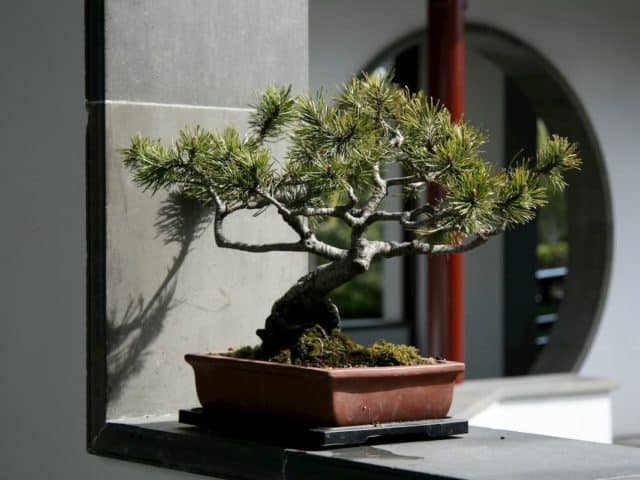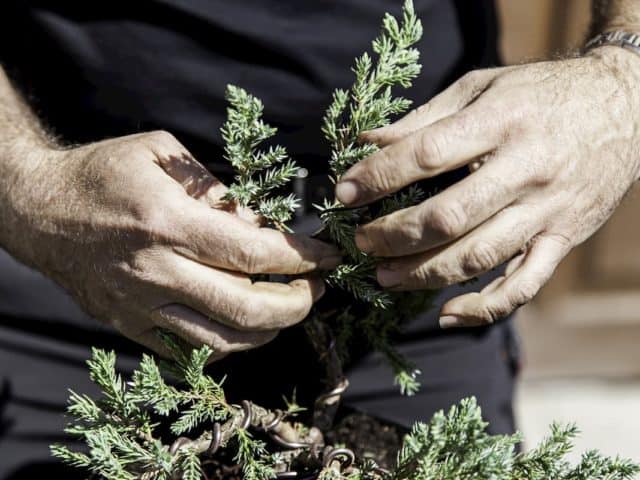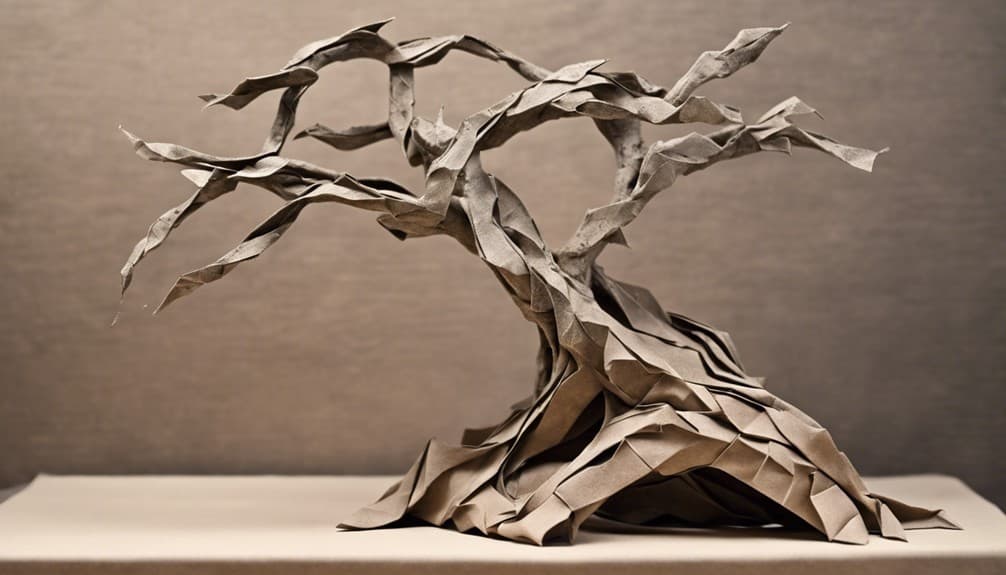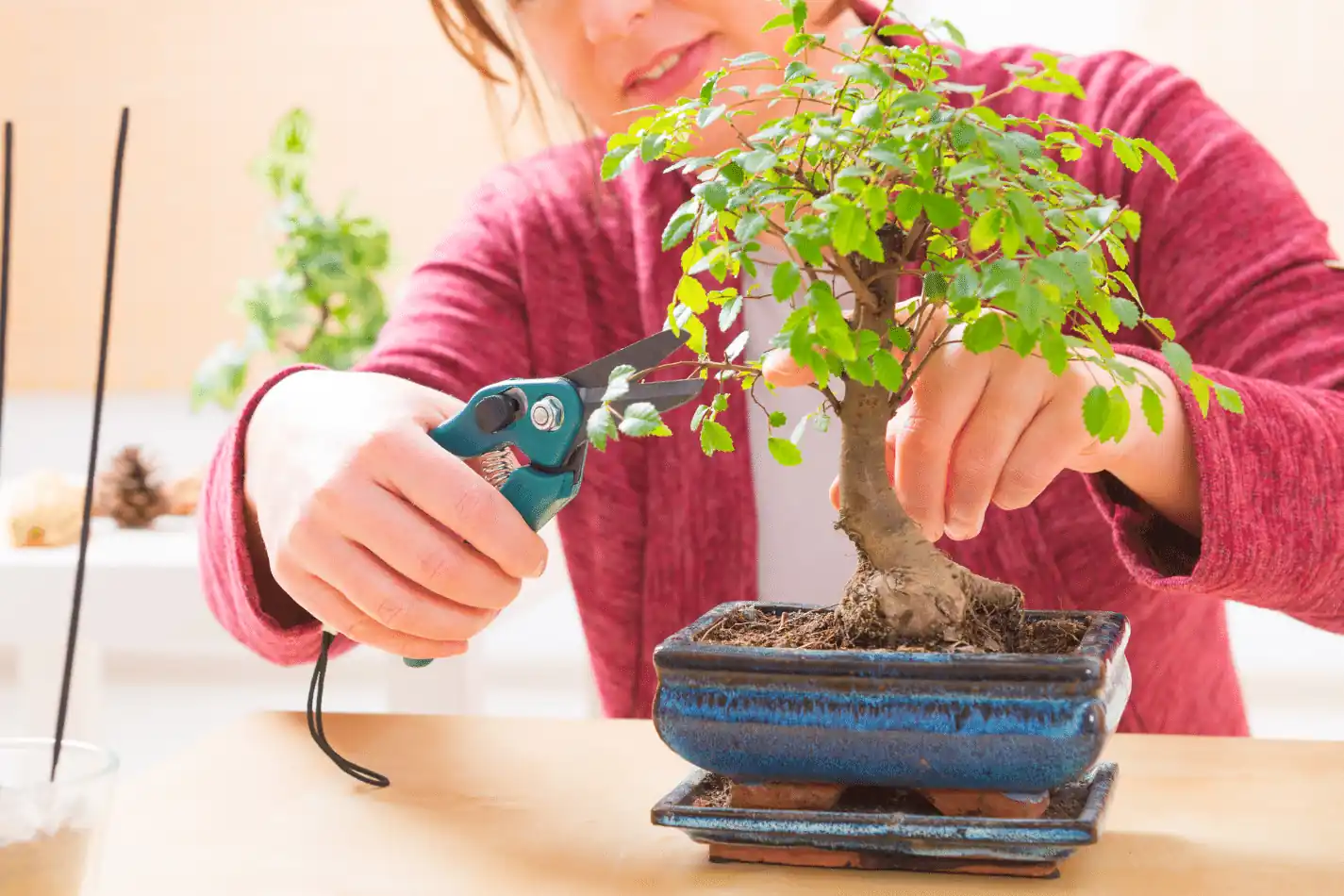Bonsai are truly amazing pieces of living art. One look at them and you cannot help but be captivated by the artistic genius and tremendous creativity of the miniaturized trees.
For someone interested in keeping indoor bonsai, a question may normally arise, how long do indoor bonsai trees live?
The life expectancy of a bonsai kept indoors depends on the species you decide to make a bonsai out of and the care you put into it. Bonsai trees, when kept in optimal condition, live just as long as their full-sized counterparts and often even more.
In this article, I will try to explain the life expectancy of indoor bonsai trees and which ones to keep indoors.
I will also try to discuss how you can take care and increase the life of your indoor bonsai and how they differ from outdoor bonsai.
Hopefully, if you read this article thoroughly you will have a better understanding of indoor bonsai trees.
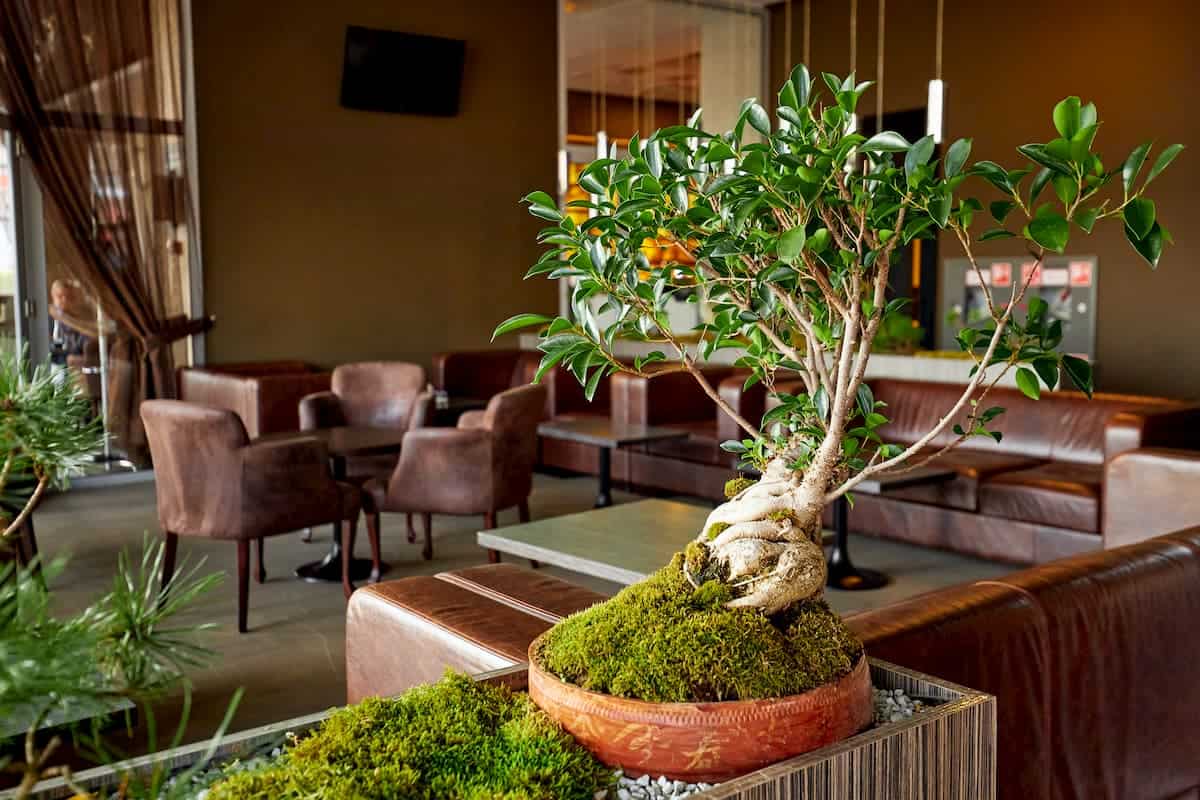
Can You Keep Bonsai Indoors?
It is a common misconception that all bonsai trees are meant to be kept indoors. That is entirely false. It is fairly easy to see why someone would make that mistake though. Something small and similarly sized to most houseplants would indeed feel very at home in a home environment.
You can’t keep just any bonsai tree indoors. In fact, most bonsai trees are meant to be kept outdoors. They might seem very different, but bonsai trees are biologically no different from their full-sized counterparts.
You have to remember that “bonsai” is not the name of any species or a special type of tree, it is the name of the art form.
You can only keep a very limited number of species of bonsai trees indoors.
Most other bonsai trees are suited to outdoor environments. Tropical types of trees that are suited to similar weather all year round is very appropriate for indoor bonsai.
Chinese Elm, Sweet Plum, Ficus, Tea Tree, Chinese Blush Tree, Gardenia, and Boxwood, etc. are some of the common species of trees used to make bonsai indoors.
These trees are suitable for indoor bonsai because they do not need the temperature drop that happens during winter for their proper growth cycle.
So, if you choose the correct breed you can definitely grow a bonsai indoor without the need for gardening space. In our modern-day society, a lot of people do not have space for a proper garden, so having a bonsai tree indoors can indeed be very enticing for all the nature lovers among us.
If you are to grow the plant from seed you will need to get the right species’ seed. A lot of people choose to grow from seed because of the amount of control they have over it.
On the other hand, if you get a pre-grown tree then you will need to confirm its species from the place you got it from. Most people get a pre-grown tree because of convenience.
The care for indoor bonsai is also a bit different from the ones kept outdoors. A few things you will need to do like maintaining light and humidity to ensure the good health of your indoor bonsai.
If you keep the right species of trees with the right care you can absolutely have your own indoor bonsai tree. The most important skill to have when creating bonsai is patience.
So be patient with your indoor bonsai tree too and hope you will soon have a beautiful piece of living art in your home.
How Long Do Indoor Bonsai Trees Live?
Like I have already mentioned, it is essential to know that bonsai trees don’t start out as bonsai trees. They are pruned and controlled and made into bonsai trees.
They start their life like any other sapling of their species. If kept in their natural habitat they too will grow tall and spread out their branches.
Bonsai trees live long, they easily live up to 50 to 80 years if routinely cared for. A lot of famous bonsai trees are more than a few hundred years old.
There are some bonsai which are more than a thousand years old. This situation is the same both for outdoor and indoor bonsai trees. Indoor bonsai can live very long lives when cared for properly.
How long do bonsai trees take to grow? Well, that too depends on the species. A bonsai tree’s growth might be stunted, but that does not mean it stops growing.
It keeps growing every year to some extent because it never ends up growing to its full height. Usually, about 5 to 7 years in a bonsai tree starts to take a proper elegant shape.
Bonsai trees are kept under heavily controlled situations. They are kept in pots that restrict the growth of their roots. They are also routinely pruned to keep their growth the way the artist wants.
Their water and fertilizer levels are also kept in check. These controlled environments do not put any damper on their lifespan.
Quite the contrary, they live just as long as their full-sized counterparts. Bonsai trees often live even longer than their natural counterparts.
The care and nutritionally well situation ensure that they live their life to the fullest. So, the life expectancy of the bonsai tree is similar to the natural trees of that species.
A bonsai of a specific species is genetically and biologically identical to a fully grown tree of that species. There are no biological reasons for why a bonsai would not live the same amount of time the fully grown tree would live. But a bonsai tree usually lives much longer.
A bonsai tree usually lives almost 25% more than a natural tree of that exact species. Bonsai trees do not grow anywhere near their full length, so they do not exhaust their growth. A regular tree’s growth gets exhausted after a certain period, and they start their journey towards death.
This does not happen for a bonsai tree. They can live as long as they are kept fresh and with nutrients. Bonsai trees are replanted in new pots every two years or so, which rejuvenates the roots.
This rejuvenation keeps the tree fresh and thriving. They are also kept far from diseases which helps expand their lifespan even further.
The pruning of both the leaves and branches and even roots keep the bonsai tree living for a lot longer than their regular lifespan. Theoretically speaking, a bonsai tree could live indefinitely as long as it’s pruned and kept with nutrients.
Your indoor bonsai tree can also live a similarly long life as long as you prune and care for it. If everything goes well, it can even last generations. The lifespan leads to both the species and the care you put into it. And, well, a bit of luck because you never know what might happen.
A regular Chinese Elm tree lives anywhere from 50 to 150 years, a bonsai tree would live even longer. Ficus, Boxwood, Sweet plum, and many other indoor bonsai trees easily live upwards of 50 years.
The oldest known bonsai tree in the world is a Ficus bonsai tree in Italy, which is over a thousand years old.
A lot of prestigious bonsai trees are over a hundred years old. A large number of them are of the indoor variety. You can also expect that your indoor bonsai tree will live a very long and beautiful life. It is often said that bonsai isn’t a race towards a destination but a journey. So, be patient.
Differences Between Indoor and Outdoor Bonsai
Some bonsai trees can be kept in both indoor and outdoor environments. But most bonsai trees are either suitable for outdoor gardens or indoor spaces, not both. Specific species of trees are selected for indoor bonsai.
Outdoor bonsai trees are like most forest trees, they require a temperature drop in winter for their yearly growth cycle.
They need that winter rest period where the growth for that year stops so the cycle can begin again in the spring. These trees are used to the temperature changes all year round.
Outdoor bonsai also don’t need much added light or watering as they get a lot of rain and sun already. The seasonal changes are integral to their life cycle. These are woody, stemmed plants. Some of these species are Oak, Pine, Japanese Maple, Trident Maple, etc.
On the other hand, the species used for indoor bonsai are not used to the seasonal temperature changes. That is because these species are from tropical or subtropical regions. Tropical or subtropical regions do not have that much of a temperature change due to the seasons.
Tropical and subtropical regions have somewhat of the same weather all year round. So, trees from that region are suitable for being kept in the same environment all the time. Our indoor climates do not change as much, so they are suitable for subtropical and tropical bonsai trees.
These trees can not handle the cold, harsh winter outside as they are not native to such low temperatures. They also need a lot of sunlight for them to prosper. In the morning and the afternoon especially. Long-lasting sunshine is a tropical weather specialty.
As I have mentioned already, some of the species well-known for indoor bonsai are Chinese Elm, Sweet Plum, Ficus, Tea Tree, Chinese Blush Tree, Gardenia, and Boxwood, etc. these plants can be treated and cared for very similarly to houseplants. So, that makes them very easy to care for indoors.
Indoor bonsai trees are meant to be kept in a warm and humid environment. As they are tropical plants and might not be native to your region, the methods for keeping them healthy will also be a bit different.
How To Tell The Age Of A Bonsai Tree
Bonsai trees grow more beautiful and become more and more valuable with their age. The older a bonsai tree is, the more significant it becomes.
So, it almost becomes essential to know the age of this living art piece. There are many ways you can do that and let me discuss those here.
In determining the age of trees, the most common way is cutting them down and counting the rings in their interior. Every year the growth of a tree adds another layer to its core. If you count the core rings after you’ve cut the tree down you can easily determine the age of the tree.
You can definitely do this to a bonsai tree too, but you really don’t want to. You would not want to cut down a bonsai tree that might be an artwork many years in the making just to determine its age.
So, this method is out of the question when it comes to bonsai trees. Thankfully there are other methods for determining the age without damage.
The most reliable and surefire way of determining the age of a bonsai tree is obviously just to keep count. It might seem obvious, but it is what it is.
If you got your bonsai tree pre-grown from a nursery or seller you can ask them how old it is when you are buying and then start keeping a count.
If you are one of the people who decide to grow their bonsai from seed, then you will have a much easier time telling the age by keeping count.
Bonsai artists care less about the age of the tree and more about its elegance and beauty. Usually, a bonsai tree’s age does not become a huge question until it’s been owned for two generations or more.
The age of a lot of the old bonsai which are cared for by multiple generations of people are recorded like this by keeping count of the years.
However, if you are not able to get in touch with the seller or the seller cannot tell you the age then keeping count becomes impossible. At that point, your bonsai tree could be a hundred years old and you won’t know.
There’s another method to very accurately estimate the age of a bonsai tree. This method is based on the growth factors of each tree. First, you would need to know the diameter of your bonsai tree. You can learn the diameter by dividing the circumference with pi.
You would need to measure the circumference of the tree about 1 inch above the roots. You will need to measure the part of the tree that is firmest in growth.
After you have found out the diameter you will need to look up the specific growth factor of that species of bonsai tree.
Different species of trees have different growth factors. You will need to have identified the species of the bonsai tree you have correctly.
After that, you need to look up the growth factor of that specific bonsai tree species. You would need to multiply the growth factor with the diameter of the tree that you calculated.
There are websites that document the growth factors of different species so you can easily find the one you are looking for. Some websites even offer more simplification and do all the math for you. This method is a very easy way to get a rough estimate of the age of your bonsai tree.
However, that is all you will get, a rough estimate. This method is not guaranteed to give you the exact age in years of your bonsai tree.
If you wish to find that out though, what you can do is take a sample of your tree and send it to a lab where they can test it and determine its exact age.
Laboratory testing will get you the most accurate results. It can tell you the exact age of a bonsai tree. But it is also somewhat inaccessible.
Not everyone is in the vicinity of a lab they can send a sample to. Not all labs take samples even. And not to mention, this is a very costly method.
But, this is by far the most trusted method. Many of the world’s oldest bonsai trees have had their ages determined through laboratory testing.
When you have a tree that has been passed down for many generations or a tree that was out of the public eye for who knows how many years, this is how you would go about determining the age.
A lot of the few hundred years old and even thousand-year-old bonsai were found in certain places. Many of these do not even have their history documented at all. So, laboratory testing is the only way to know their age.
So, when it comes to how to tell bonsai tree age your best method is keeping count. You can use the growth factor method to get a rough estimate. And, in extreme cases, you can even choose to send a sample to some lab to do some testing for you.
Some of The Oldest Indoor Bonsai Trees
Bonsai trees have a reputation for having extremely long lifespans. Many reputed bonsai trees are easily over a hundred years old.
Many bonsai trees have been cared for by multiple generations of artisans. Indoor bonsai trees are not exempt from this status of living very long lives.
Some of the world’s oldest bonsai trees are in fact of the indoor variety. Let me discuss with you some of these so you can feel more encouraged about your indoor bonsai tree too.
‘Chabo-Hiba’ Hinoki Cypress Tree in Boston
The ‘Chabo-Hiba’ Hinoki cypress tree is dated back to 1787. Which makes it more than 230 years old. And cypress trees can thrive amazingly even indoors. This specific cypress tree is kept in Harvard’s Arnold Arboretum.
This small but very impressive tree is said to be kept in the same pot throughout all of its lifespan, which makes it all the more impressive. It takes very careful and skillful pruning to keep this bonsai tree in shape.
The 800-Year-Old Tree at Shunkaen
The Shunkaen Bonsai Museum is owned by Kunio Kobayashi. This museum holds some of the most amazing pieces of bonsai ever known. This museum is home to two of the oldest known bonsai trees.
One of them is a Juniper of the outdoor variety. But the other one is an indoors one. Which is currently being kept inside an enclosure.
This tree looks relatively simple compared to many other bonsai trees. But, it is highly respected as one of the oldest bonsai trees in the world. This simple yet elegant tree is over 800 years old.
Ficus Bonsai Tree in Italy
There is a Ficus bonsai in the Crespi Bonsai Museum in Italy. This ficus bonsai is believed to be the oldest bonsai tree to ever exist. This bonsai tree is well over a thousand years old. This is basically the holy grail of all bonsai artists.
Luigi Crespi, the founder of the Crespi Bonsai Museum spent ten years trying to gain ownership of this bonsai tree. He succeeded in doing so in 1986. This bonsai had been in the care of many generations of Chinese bonsai masters.
In the early years of its being in Italy, it was cared for by Japanese master Shotaro Kawahara. Luigi Crespi even put this bonsai up for exhibition at a fair after he had gotten ownership of it after ten years of negotiations. It is currently sitting at the Crespi museum in all its thousand-year glory.
So, that goes to show the potential of bonsai trees. When a tree has lived for well over a thousand years, imagine what things it has lived through.
Generations of humans, civilizations, wars, everything. Well, who knows, maybe the indoor bonsai you have in your house today could end up being alive after a thousand years, you never know!
How Do You Look After Indoor Bonsai?
Indoor bonsai trees have some specifics about their care and upkeep. They are accustomed to the high sunlight environments of the tropical regions, so their care is different from outdoor bonsai. Bonsai trees are also kept in small containers, which means they are different from houseplants.
When it comes to the care of indoor bonsai trees there are a few specific things you need to keep in mind. Light, humidity, watering and fertilizing, and temperature. I will discuss these right here.
Other than these specifics, the pruning, repotting, and other aspects of bonsai care are identical to that of outdoor bonsai trees. You will still need to prune and change the containers of your indoor bonsai tree every few years just like you would with an outside bonsai tree.
Light
Tropical and subtropical regional trees are used to having a lot of sunlight. The main problem with keeping a bonsai tree indoors is that the light indoors is much less intense than outside.
So, it is a good idea to have the bonsai near a window where it can get a lot of sunlight, especially in the morning and afternoon.
You can supplement the lack of sunlight with artificial lamps. There are many lamps made specifically for this purpose. These lamps emulate sunlight so your plant can be healthy.
If you have one of these lamps running for a few hours every day you should be fine,
Humidity
Another problem is the humidity. Indoor bonsai trees require a very humid atmosphere. Much more humid than our regular indoor environments.
Tropical environments have very high humidity when compared to other environments. That is the environment these trees are meant to thrive in.
Your home’s humidity is way lower than that of the tropics. It is in fact very dry. You can manage this by placing a humidity tray filled with water or misting the tree by spraying water.
You can also try circulating outside air by keeping the windows open for a while.
Watering & Fertilizing
Watering is another important thing when it comes to indoor bonsai trees. Unlike outdoor bonsai trees which get a lot of water from rain, indoor bonsai trees don’t.
What you need to avoid is watering on a routine. It can end up making the soil overly watery. You should water the bonsai tree whenever the soil feels dry, so it remains relatively moist.
Similarly, bonsai trees do not require much fertilizing. You should not put fertilizers on a routine. You should put in very little amounts of fertilizers whenever the soil starts to feel dried out or dead.
Temperature
As I have mentioned before, tropical and subtropical trees are the ones picked for indoor bonsai. These trees cannot withstand the extremely harsh winters and do not survive in such low temperatures. They require high-temperature environments.
Tropical trees need very high temperatures while subtropical ones can withstand somewhat low temperatures. But you will need to monitor the temperature.
These trees cannot survive if the temperature goes below 40-50 degrees Fahrenheit. You will need to run a heater to compensate for the temperature drop if it is ever needed.
Final Thoughts on How Long Do Indoor Bonsai Trees Live
As you have read finding the right tree and growing them indoors can yield incredibly long lasting plants that will stand the test of time for you and your family.
Just make sure to take the time and make a choice of a tree that can be successfully grown inside and is able to withstand a loss of overall natural light.
If you are just learning about bonsai trees and looking to purchase high quality trees that will likely live longer than you then I would highly suggest checking out Bonsai Boy Trees as they are a long lasting New York business that provides trees for all price ranges!


